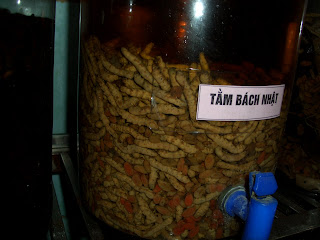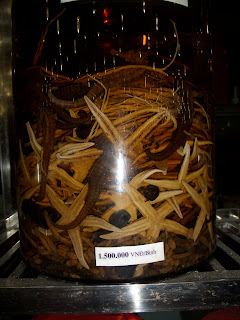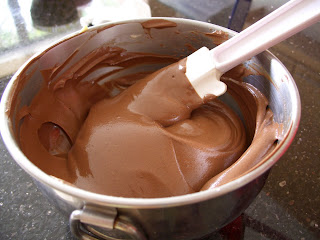Day 1 - in Hanoi Old Quarters
Ate breakfast at the hotel (Hanoi Cozy Hotel) as it is included in the US$25 per night which was 2 sunny side up eggs with toast, fruits and juice. It was okay, as with the rooms, but after our trip to Halong Bay we are definitely looking for a nicer one :) It was not a terrible hotel but the two reasons why we wanted to switch are...

Reason 1: The rooms are clean but old

Reason 2: Situated a super busy street & the traffic waking you up at 6am!
After breakfast, we embarked on an Old Quarters Walking Tour
Start: North end of Hoan Kiem Lake (at the Ngoc Son Pagoda).
Finish: Return to the north end of Hoan Kiem Lake (to Dong Kinh Nghia Thuc Sq.).
Time: We began at about 10am and reached back our hotel at about 4pm.
1. Hoan Kiem Lake

Start with a visit to the Ngoc Son pagoda on the north end of the lake. Cross the red Bridge of the Rising Sun to reach the temple.(we didn't go in, we just glanced from the outside) From this most prominent point in the city, follow the northern edge of the lake heading west and cross over the busy traffic circle. This busy square is known as the Dong Kinh Nghia Thuc Square (The Tonkin Free School Movement Sq.), named for the early-20th-century nationalist movement that would eventually spawn grassroots Communism in Vietnam.
Tips for crossing the streets in Hanoi:
1. Don't look left or right and left again before crossing the street
2. Focus on the destination and walk at a steady pace.
3. Don't stop or speed up while crossing the streets even if you see a million motor bikes coming at you!
4. Trust the motorists, because they WILL avoid you not the other way round.
West from the square is:
2. Hang Gai Street (Hemp St.)
This busy avenue marks the southern boundary of the Old Quarter. Hang Gai no longer supports hemp outlets as in days of old (the street would also host print shops and bookstores in the 19th c.) but is lined with boutique shopping, galleries, and silk tailors. Just a few hundred meters west of the traffic circle (on the left) you'll find a large banyan tree out in front of what was once a prominent communal house at no. 85 Hang Gai. The tree is one of the finest specimens of an old banyan in the city, a perfect example of nature's adaptability as heavy roots cleave large stones and masons have built around the old tree for centuries. The sight is like a small temple, with sticks of incense wedged between knobs of the tree and offerings of rice whiskey lining the base of the tree.

Turn right at the end of Yen Thai Street onto Hang Da Street: 3. Hang Da Market and Hang Dieu Street
At the intersection of Yen Thai and Hang Da is the Hang Da Market, which is a large, local dry-goods and clothing market. After a quick look, head north on Hang Da -- don't miss the large bird shop with a wall of bamboo cages on the northern corner of the Hang Da Market.
Continuing north, Hang Da becomes Hang Dieu Street. Hang Dieu was traditionally the area for tobacco and pipe sellers; keep an eye out for the filigreed colonial edifices at no. 66 and no. 77 Hang Dieu (you'll have to look up to distinguish these from the concrete clutter).
4. Take a BreakBun Bo Nam Bo , at 67 Hang Dieu St. (tel. 04/923-0701), serves one of Hanoi's most popular one-dish noodle specialties.

Turn right off of Hang Dieu onto:
5. Bat Dan Street
This street once housed sellers of clay bowls that were brought to the city from riverside workshops along the Red River. No. 33 Bat Dan is a very ornate and colorful communal house.
Turn left (go north) on Thuoc Bac Street, once an area for traditional medicines. Then turn left (west) on:
6. Hang Phen Street
At the corner of Hang Phen and Bat Su, look for a preserved traditional house, characterized by its low tile roofline, at no. 52 Bat Su (also note the cozy little coffee shop on the corner, good for a rest and to watch the busy street life).
We made a beeline for a hotel that we might want to switch to to check out the rooms, which we did stay there for the remaining nights in Hanoi after our return from Halong Bay. A much better hotel - Hanoi Boutique Hotel, also for US$25 and including breakfast( which had Pho on the menu!). The staff were also very helpful.
Carry on along Hang Phen until it becomes Cua Dong Street, which brings you to the eastern edge and wall of the Hanoi Citadel built by the Nguyen dynasty in the 1800s. Cua Dong Street terminates at the wall of the Hanoi Citadel.
Turn right off of Cua Dong onto:
7. Phung Hung Street
Running along the wall of the city's old citadel, what marks the western edge of the Old Quarter, Phung Hung Street is a notable sight among Vietnamese tourists for the publication offices of an important Communist paper at no. 105 Phung Hung. There's a plaque that notes this spot as a historical vestige, but if you spend too much time studying the shuttered colonial edifice, local folks might get edgy, thinking you're a spy of sorts.
Turn right off of Phung Hung onto:
8. Hang Vai
Translated as "Cloth Street," Hang Vai is the bamboo district. The busy exteriors of small warehouses are lined with stands of cut bamboo poles, some more than two stories in height. This is the raw material for those wonderful Doctor Seuss scaffoldings you see on construction sites. The shops also sell bamboo tobacco pipes of the "bong" variety, some quite elaborate. At the corner of Hang Vai and north-south Hang Ga, keep an eye out for the communal house at no. 44 Hang Ga St.: A corner door cut into the white plaster and flanked by Chinese script ushers you into a small courtyard area with banyan trees and a small temple to Bach Ma, the White Horse, a god associated with Hanoi. Carrying on east on Hang Vai, look for the entrance to the communal house at no. 7 Hang Vai.
Heading east, Hang Vai becomes:
9. Lan Ong Street
One of the most interesting parts of the Old Quarter, Lan Ong Street is still home to a large enclave of ethnic Chinese who sell the herbs and medicines of old from small storefronts that date back to the origins of the quarter. The best shops are on the right side as you head east. Here you'll find picturesque little interiors with walls lined in massive dark wood cabinets with tiny drawers and buckets and bins all around with the most curious assortment of dried goods you'll ever see. This is the kind of place where, sadly, you might be able to buy a bear's gall bladder or a monkey's paw. The buildings all along this short stretch are originals dating back as far as the 17th century. Look for the busy elementary school at no. 42 Lan Ong, which was once the communal house of the area's Chinese population. Just across from the converted communal house and all along the length of the street, look for low roofs and narrow entries, especially those with tile roofs covered in moss, as these are original Chinese homes.
A quick left (north) turn brings you to:
10. Cha Ca Street
Following Lan Ong Street, heading east, cross the famous Cha Ca Street (Fish St.). Make a left (north) and look for the Cha Ca La Vong, which serves one of Hanoi's most famed dishes. Do not get tricked!!! There's an imposter restaurant called Cha La La Vong that we went in to eat this ...


... served with some noodles and chincalok type sauce. It was okay but nothing compared to Bun Bo Nam Bo, thank God we ordered one serve, also it wasn't cheap, it cost usabout S$10.
So, after the meal we walked further down the street and to our dismay, we saw THIS...

 Sigh, we got duped :( Anyway, perhaps desserts coming up would make up for the silly mistake!
Sigh, we got duped :( Anyway, perhaps desserts coming up would make up for the silly mistake!
11. Take a Break
Just across from Cha Ca La Vong restaurant, you'll find the Hoa Sua Cafe(11B Cha Ca St.; tel. 04/923-1500), a combination school and restaurant (they now have a number of locations throughout the city), where young students serve good coffee and cakes. (We didn't stop and buy anything because the desserts looks like Breaktalk from Singapore!)
Returning to eastbound Lan Ong, turn left (north) onto Hang Duong.
13. Hang Duong Street
Hang Duong Street (Sugar St.) is lined with traditional constructions, foremost of which is the communal house on the left as you go north at no. 38 Hang Duong St. It has a stunning banyan tree in the courtyard and a dark, alluring charm to its smoky interior. Note: Hang Duong is a pedestrian area on weekend nights and becomes a busy little market for tourist trinkets and local goods.
Also spend some time in Dong Xuan Markets which reminded me of Tekka Market, just bigger!

A short detour off of Hang Duong is the 13th-century Thanh Ha Communal House, just a short walk east on Ngo Gach Street (Brick St.).

Continue north on Hang Duong, then turn right on:
12. Hang Chieu
Follow Hang Chieu east across the northern end of the Old Quarter to Quan Chuong Gate, the only remaining gate of the city's once-formidable fortifications. From here, go right (south) onto Dao Duy Tu Street and look for the small entrance to the Huong Nghia Communal House on the left side near the corner of Cho Gao Street.
13. Take a Break
Tired? Thirsty? On the corner adjacent to the communal house on Hang Chieu is a popular bia hoi stand and restaurant where you can get a mug of local brew and get out of the heat for just 1,500 VND (10¢/£0.05).
Turn right onto Nguyen Sieu.
14. Nguyen Sieu Street
Nguyen Sieu is a street named for a noted 18th-century scholar and lined with colonial buildings (your architecture-spotting muscles must be strong by now).
Turn left (south) on Hang Giay Street. Go straight 1 block. Then turn left on Hang Buom Street. Immediately on your left is the important:
Continue east along:
15. Hang Buom Street
From the Bach Ma Temple, continue east on Hang Buom (Sail St.). Once adjacent to a small tributary of the To Lich River, which brought goods to the city, Hang Buom was where local merchant vessels came to refit their ships. Look for the many colonial buildings and traditional Vietnamese houses, as well as a communal house at no. 22 Hang Buom.
As Hang Buom curves to the right (south), it becomes:
19. Ma May Street
Ma May is the beginning of the busiest budget tourist areas of the Old Quarter. In and among Internet cafes and tourist restaurants (often one and the same), you'll find good examples of traditional and colonial buildings. The Huong Tuong Communal House is at no. 64 Ma May, and one of the most interesting sights in the city can be found at no. 87 Ma May, a refurbished and restored traditional house. Here, for a fee of just 20,000 VND ($1.30/£0.70), a young docent dressed in a traditional flowing ao dai gown will take you on an informative tour of the building and can explain important details about life in the Old Quarter in centuries past. With the careful renovations done by a UNESCO-funded, French- and Canadian-backed organization, this classic home offers a unique opportunity to have a close look at the interior detail of a traditional Old Quarter home. Also see the similarly renovated property at no. 38 Hang Dao St. .
Ma May also houses some fine services, such as Tamarind Café, where you can grab something to eat, check your e-mail, and shop for trinkets. Heading south on Ma May, turn right at its terminus with:
20. Hang Bac Street
Heading west on Hang Bac, you're in the heart of the backpacker area. Here you're sure to be assailed on all sides by touts and hucksters and have your pick of budget tours from the many storefronts that line this busy street. Hang Bac means Silver Street and the silver these days is mostly the stuff coming from your pocket and falling into tour operators' hands, though you still can find some silver (and gold) jewelry makers and sellers.
As you approach the intersection of Dinh Liet Street, look right and you'll see the large Chuong Vang Theater at no. 72 Hang Bac, which was the stronghold of troops who laid siege to the French after the August Revolution in 1945.
You'll find good shopping and lots of goods and services in this area. You can finish the tour here, or check out one more sight worth seeing.
Head west on Hang Bac. Turn left (south) on:
21. Hang Dao
Immediately on your right, don't miss another fine example of a restored traditional Old Quarter house, much like the one on Ma May (and run by the same folks). No. 38 Hang Dao is a two-story home that was once owned by silk merchants. Quite spacious and elaborate (silk merchants were wealthy), you'll see how an Old Quarter house was set up, including where the worship area was set (now an office), as well as where the family lived, cooked, and worked. Helpful docents guide you through for a fee of 20,000 VND ($1.30/£0.70) (or for free if you've got your ticket from Ma May St.).

Hang Dao continues south and ends at Hang Gai and the Dong Kinh Nghia Thuc Square (The Tonkin Free School Movement Sq.). Look for the large ocean-liner-shaped building that overlooks the square and Hoan Kiem Lake to the south.
22. Take a Break
On the fourth floor of the most prominent building on Dong Kinh Nghia Thuc Square, find the popular Highland's Coffee, a good place to meet up after your walk or to rest your bones after completing the circle.
We then headed back to the hotel to wash up to go for dinner. Over the internet I read a review about this place Samson Seafood restaurant and sounded so yummy that I included it in our food plan... MISTAKE number 2 after the afternoon's boo-boo with Cha Ca Va Long.
 The place looked promising, with no tourists and many Vietnamese locals, this place must be good! We were taken to the 2nd floor , they have 3 floors (another 'good' sign) and we had some what of a pleasant view (another 'good' sign)
The place looked promising, with no tourists and many Vietnamese locals, this place must be good! We were taken to the 2nd floor , they have 3 floors (another 'good' sign) and we had some what of a pleasant view (another 'good' sign)
 and then things started to go down hill from there when we began to flip through the English menu which was very interesting, they had...
and then things started to go down hill from there when we began to flip through the English menu which was very interesting, they had...
 SALAMANDER?!?!?!?!
SALAMANDER?!?!?!?!
 PORCUPINE?!?!?!?!
PORCUPINE?!?!?!?!
We went with NORMAL like oysters, fish, crabs and veg which were salty, ugly , dry and grassy!


 After that very tragic dinner, I thought what else could go wrong... sigh like a horror movie, the scariest bits are saved till the very end. We paid up and while waiting for the restaurant to call us a taxi back to our hotel my too-curious eyes stumbled upon the very sought after tonic drinks with ....
After that very tragic dinner, I thought what else could go wrong... sigh like a horror movie, the scariest bits are saved till the very end. We paid up and while waiting for the restaurant to call us a taxi back to our hotel my too-curious eyes stumbled upon the very sought after tonic drinks with ....
 WORMS???!!!?!?!
WORMS???!!!?!?!
 STARFISHES?!?!?!?!?!
STARFISHES?!?!?!?!?!
 LIZARDS?!?!?!?!?!
LIZARDS?!?!?!?!?!
I wanted to get back to the hotel FAST and think happy thoughts of leaving for Halong Bay tomorrow. Thank God I had no nightmares about the dinner *whew*




















































